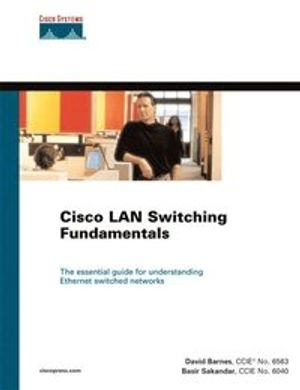The essential guide for understanding Ethernet switched networks
Understand various Ethernet technologies from 10BASE-T to Gigabit Ethernet Learn about common switching modes, paths, and architectures Delve into the Cisco Catalyst switch architecture and examine the various Catalyst switch models, including the 6000/6500, 4500, and 3750 Become familiar with VLAN concepts, including types of trunks, VLAN Trunking Protocol (VTP), and private VLANs Understand Multilayer Switching (MLS) and the various hardware components that make MLS work Learn how to configure Cisco Catalyst switches in both native and hybrid mode Implement QoS on Cisco Catalyst switches Deploy multicast features and protocols, including PIM, IGMP snooping, and CGMP Utilize data link layer features such as BPDU Guard, BPDU Filter, Root Guard, Loop Guard, RSTP, and MST Evaluate design and configuration best practices Learn how to manage LANs and troubleshoot common problems Local-area networks (LANs) are becoming increasingly congested and overburdened because of a dramatic increase in traffic, faster CPUs and operating systems, and more network-intensive applications. Many organizations that use network and computing technology use LAN switching to take advantage of high-speed traffic forwarding and improved performance of traditional Ethernet technologies that don't require costly wiring upgrades or time-consuming host reconfiguration. Cisco LAN Switching Fundamentals provides administrators of campus networks with the most up-to-date introduction to LAN switching within a traditional Ethernet environment.
Cisco LAN Switching Fundamentals presents an in-depth look at modern campus network requirements. It provides an easy-to-understand introduction to LAN switching best practices using Cisco Catalyst switches. This book provides you with a wealth of details on the architecture, operation, and configuration of the Cisco Catalyst family of switches. You learn about a wide range of topics, including quality of service (QoS), multicast, Rapid Spanning Tree Protocol (RSTP), Multiple Spanning Tree (MST), private virtual LANs (VLANs), and configuration using the native and hybrid software interfaces. Design advice and configuration examples are discussed liberally throughout the book to provide you with the best perspective on effective deployment techniques. Finally, the book wraps up with a discussion of steps necessary to troubleshoot common problems and optimize LAN performance.
Whether you are looking for an introduction to LAN switching principles and practices or a Cisco Catalyst configuration and troubleshooting reference, this book provides you with the invaluable insight you need to design and manage high-performance campus networks.
Åtkomstkoder och digitalt tilläggsmaterial garanteras inte med begagnade böcker





















